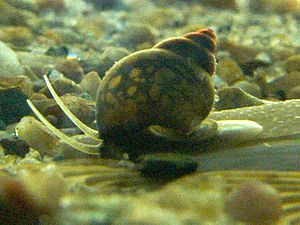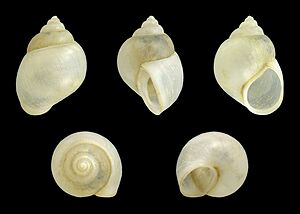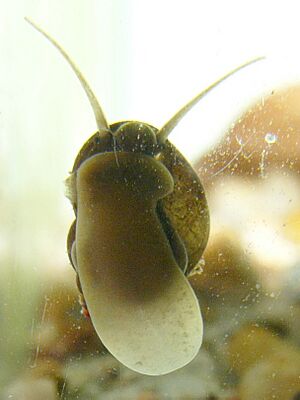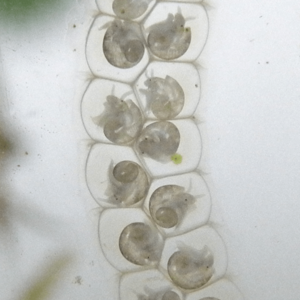Bithynia tentaculata facts for kids
Quick facts for kids Bithynia tentaculata |
|
|---|---|
 |
|
| A live faucet snail | |
| Conservation status | |
| Scientific classification | |
| Synonyms | |
|
. †* Amnicola (Amnicola) meridionalis (Frauenfeld, 1862) (described as Bithynia; junior synonym)
|
The Bithynia tentaculata, also known as the faucet snail, is a small freshwater snail. It has gills, which help it breathe underwater, and a special "door" called an operculum that can close its shell. This snail is an aquatic mollusk and belongs to the family Bithyniidae.
Contents
About the Faucet Snail
The faucet snail is the main example (or type species) of its group, called Bithynia. Scientists study different forms of this snail, but they all belong to the same species.
Where Faucet Snails Live
Natural Homes
Faucet snails are naturally found across a large area called the Palearctic region. This includes many parts of Europe.
In Northern Europe, you can find them in:
- Scandinavia
In Central Europe, they live in:
- Czech Republic (where they are common)
- Germany (common overall, but rare in some areas like Saxony and Thuringia)
- Poland
- Slovakia
In Western Europe, they are found in:
- Great Britain and Ireland
- Netherlands
In Eastern Europe, they live in:
- Ukraine
In Southeastern Europe, they are found in:
- Bulgaria (in the northern parts)
- Croatia
Introduced Locations
The faucet snail has also been introduced to places where it doesn't naturally live. It is now found in the United States and Canada.
In the Great Lakes Region of North America, the faucet snail was first seen in Lake Michigan around 1871. It then spread to other large lakes like Lake Ontario and Lake Erie. By 1992, it had spread from Quebec and Wisconsin to Pennsylvania and New York.
In the Mid-Atlantic Region, it lives in Lake Champlain and the Potomac River in Virginia. It has also become established in Chesapeake Bay, Maryland.
What the Faucet Snail Looks Like
The shell of a faucet snail is usually about 12 to 15 millimeters (about half an inch) tall. When the snail's shell reaches about 8 millimeters, it is old enough to reproduce. The shell is typically 5 to 7 millimeters wide.
The snail's shell is shiny and pale brown. It has an oval shape with a rounded top, made of 5 to 6 slightly flattened turns, called whorls. It doesn't have a belly button-like opening (called an umbilicus) and has a very thick edge around its opening (called a lip). The opening itself is less than half the height of the shell.
Adult faucet snails have a white, hard, tear-drop shaped "door" called an operculum. This operculum has clear rings, like growth rings on a tree. Younger snails have an operculum with spiral marks. This operculum is always very close to the shell's opening. The snail itself has long, pointed tentacles and a simple foot.
How Faucet Snails Live
Their Home Environment
Faucet snails prefer to live in slow-moving freshwater, like calm rivers, and still water bodies, such as lakes and ponds. They especially like water that is rich in calcium.
You can often find them in shallow lakes and canals. In cooler months, they stay on the bottom (on gravel, sand, mud, or under rocks). In warmer months, they move onto water plants like milfoil and muskgrass. They mostly live in shallow areas called shoals, but can also be found in water up to 5 meters deep.
What They Eat
Faucet snails eat in two ways:
- They scrape algae off surfaces like rocks and plants.
- They filter tiny algae from the water using their gills.
When they filter feed, they suck in algae, pack it together, and then eat these small packages. Being able to filter feed helps many faucet snails survive even in water that has a lot of nutrients from pollution. They can also choose what food items they eat. In some parts of the world, faucet snails are known to eat black fly larvae.
Life Cycle
Faucet snails have separate sexes, meaning there are male and female snails. Females lay their eggs on rocks, wood, and other shells. They arrange the eggs in neat rows, in groups of 1 to 77.
Egg-laying usually happens from May to July when the water is warm (around 20°C or higher). Sometimes, females born early in the year will lay eggs again in October and November. A single female can lay up to 347 eggs. The eggs hatch in about three weeks to three months, depending on how warm the water is. Faucet snails usually don't grow much from September to May. Their lifespan can be anywhere from 17 to 39 months, depending on where they live.
Scientists can study faucet snails to check for pollution like cadmium, zinc, and methylmercury in the water. This is because the amount of these harmful substances in the snails' bodies matches the amount in the water.
Other Relationships
Faucet snails can be carried to new places by birds, which helps them spread naturally.
These snails can also sense when leeches (which eat snails) are nearby. When they do, they quickly close their operculum to protect themselves from being eaten.
Images for kids






